Summary: Beans are an important part of global agriculture, but pests and diseases can impact the economies of producers like the United States, Brazil, and Australia. Biological control methods like parasitic wasps and horticultural oils can help combat pests and improve yields.
Overview
- What pests and diseases affect bean plants?
- Mexican bean beetle
- Bean leaf beetle
- Lesser cornstalk borer
- Brown marmorated stink bug
- Bacterial brown spot
- Cowpea curculio
- Southern green stink bug
- Twospotted spider mites
- Seed corn maggot
- Bean common mosaic virus
- Corn earworm
- Cowpea aphid
- How do I manage bean pests?
- Summary
- FAQ
Bean crops include common beans, peas, snap beans, green beans, and lima beans, which play an important role in the economies of large producers like Brazil, Australia, and the United States. Brazil produces about 3 million metric tonnes of dry beans each year, while dry bean exports in the United States are valued at around $425 million annually. Bean crops are vulnerable to attack from a wide range of mites, insects, and microbial infections, which reduce yields and marketability. This article focuses on identifying and controlling common bean pests (including green bean pests) and diseases, and explores the use of biological methods.
What pests and diseases affect bean plants?
Bean crops can be attacked by insects like beetles and the larval stages of fly and moth species. Spidermites are another important pest, while viruses and bacterial infections can also cause significant economic losses. About 50% of soybeans produced in the US are lost to invertebrate pests, and 30% of bean production costs go towards pest control in Brazil.
Mexican bean beetle (Epilachna varivestis)
This species of beetle damages many bean plants by feeding on leaves. Adults are yellow-orange with black dots and grow to 25 mm long. Larvae are yellow and have spines. Mexican bean beetle feeding can give leaves a skeletonised or lacy appearance. This is caused by beetle feeding on the undersides of leaves, causing the tops of leaves to dry out.

Bean leaf beetle (Cerotoma trifurcata)
This species of beetle damages many bean plants by feeding on leaves and pod tissue, with a preference for younger plant tissue. Adults are oval-shaped, may be spotted or unspotted, and grow up to 6.35 mm in length. They occur in a variety of colours, including grey, red, orange, yellow, and brown. Damage can appear as holes in leaves and damaged pods.

Lesser cornstalk borer (Elasmopalpus lignosellus)
This pest is a species of moth that damages bean plants during its larval (caterpillar) phase. Adults appear in shades of brown and have a wingspan of up to 25 mm. Mature larvae are blue/green with yellow and white stripes. Larvae feed on seedlings and bore into plant stems, stunting plant growth. Early damage appears as wilting and bud withering, but severe infestations can result in plant death.


Brown marmorated stink bug (Halyomorpha halys)
This pest damages many crop types, including bean crops, by sucking plant fluids and injecting enzymes that damage plant tissues. Adults are brown, shield-shaped, and grow to about 16 mm long. Damage appears as tiny black holes surrounded by a yellow or bright green border. Pockmarking of plant tissue can make it unmarketable, and entire crops can be lost with severe infestations.

Bacterial brown spot (Pseudomonas syringae)
This is a bacterial infection caused by the species Pseudomonas syringae, which can be present on plant tissue before symptoms become noticeable. Damage appears as brown or necrotic (dead) spots on leaves and pods, often surrounded by a lighter yellow area. The centre of these water soaked spots may fall away on leaves, resulting in holes. The bacteria primarily spread via rain splashing and fallen plant debris.

Cowpea curculio (Chalcodermus aeneus)
This pest damages cowpeas and other bean crops in its adult and larval stages. Adults are black, sometimes with a bronze tinge, and grow to 5.5 mm long. Females lay eggs inside bean pods, and larvae eat their way out of pods before dropping to the soil to form a cocoon. Adults feed on pods and leaves, and damage appears as holes in pods and seeds. Severe infestations can result in total loss of pods and flowers.
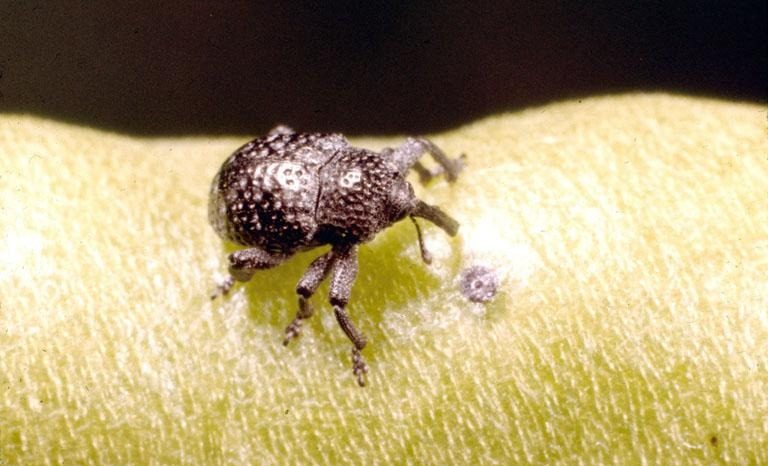
Southern green stink bug (Nezara viridula)
This pest damages bean crops by feeding on plant fluids during its adult and developmental (nymph) stages. Like other stink bugs, this pest is shield-shaped but is usually green, as its name suggests. Adults grow to between 12-13 mm and feed primarily on growing shoots, though many plant tissues are vulnerable to attack. Damage can appear as brown and black spots on plant tissues and stunted plant growth.
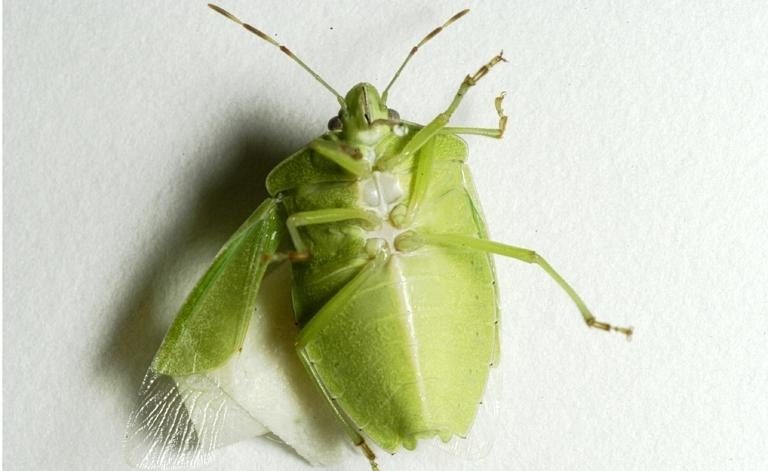
Twospotted spider mites (Tetranychus urticae)
These mite pests damage bean crops by sucking plant tissues from the undersides of leaves. Adults can be dark green or yellow and have characteristic spots on each side. They grow up to 0.4 mm in length. Damage to the underside of leaves causes white spots to appear, which can gradually spread over the whole leaf. Severe damage can result in leaf drying, and webbing will typically be present underneath leaves.

Seed corn maggot (Delia platura)
This pest is the larval stage of a species of fly that burrows into bean seeds and feeds on plant tissue under the soil. Adult flies are grey and grow to 5 mm, while larvae (maggots) are about 6 mm long and appear in shades of whitish yellow or brown. Symptoms of damage include beans taking longer to sprout. Early leaves can be visibly damaged, yellow, or missing.
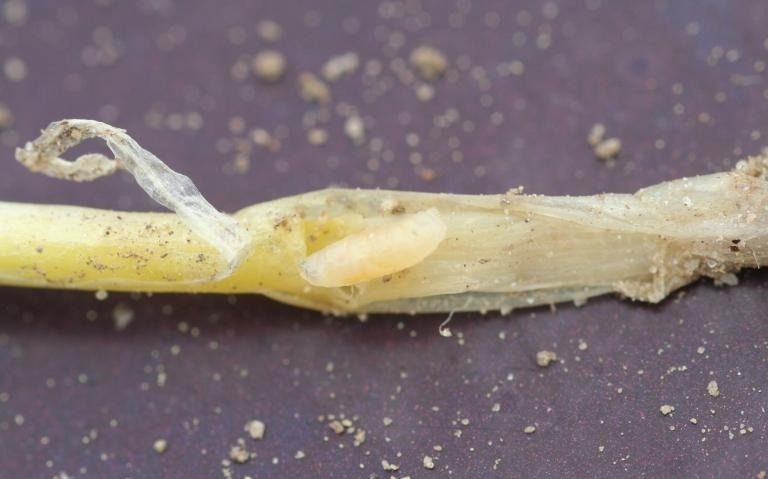
Bean common mosaic virus (Potyvirus phaseovulgaris)
This is a viral infection that causes characteristic patterning on the leaves of affected plants and is commonly transmitted by aphids and the seeds of parent plants. Patterns appear in shades of yellow-green or dark green, and can cause leaves to curl, roll, and blister. Other forms of this virus cause small red dots, and nearby veins become brown-black.
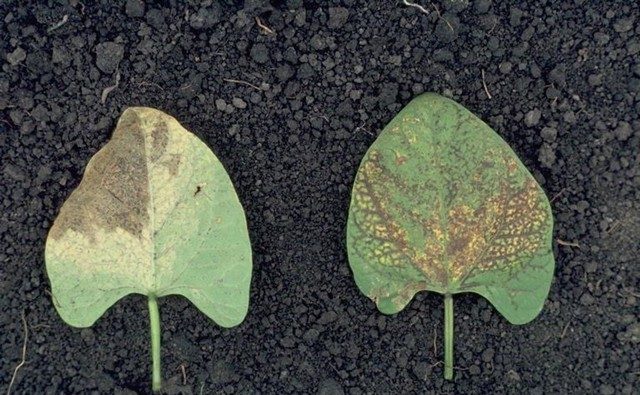
Corn earworm (Helicoverpa zea)
This pest is a species of moth that causes damage to bean plants during its larval stage. Adult moths grow to 18.5 mm long with a 37 mm wingspan and appear in shades of red-brown, green, and tan. Larvae are green-bodied with black heads and hairs. They grow to 37 mm and feed directly on many plant parts, including leaves, pods, and beans. Damage can appear as holes in leaves and bean pods.

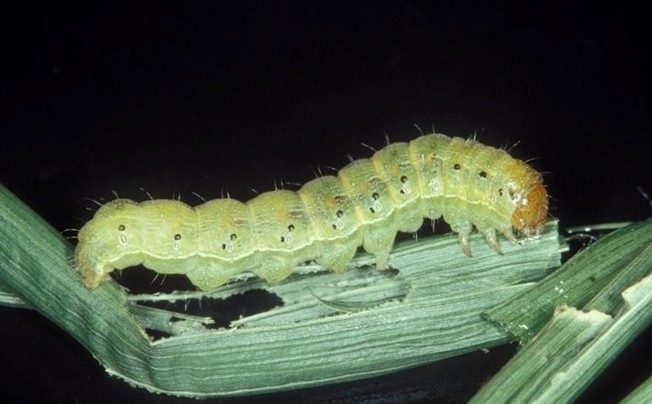
Cowpea aphid (Aphis craccivora)
This insect pest feeds on the tissues of a variety of bean crops. Adult females are dark-brown or black, have wings, and grow to about 2.2 mm. Damage appears as stunted plant growth, and severe infestations can result in plant death. Cowpea aphids secrete honeydew, which promotes the growth of sooty mould and attracts ants.
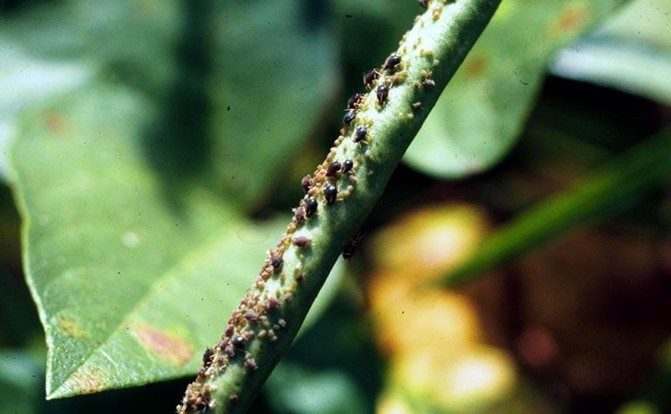
The pea aphid (Acyrthosiphon pisum) is another important aphid pest that attacks peas and broad beans.

How do I manage bean pests?
There are several methods available for managing bean plant pests. A combination of approaches using Integrated Pest Management (IPM) practices and biological control methods works well in many cases.
Monitoring
Watch for the symptoms described above. The most common symptom of pest and disease damage in bean plants is leaf discolouration, which can appear in various patterns and colours. Direct feeding of pests may be visible in the case of stink bugs, corn earworms, or seed corn maggots if underground plants are examined. Be sure to check the undersides of leaves, where pests like spider mites feed and produce webbing. A large number of adult pests, such as corn earworm moths, may also indicate an infestation, while higher numbers of ants may indicate an aphid problem.
Cultural control
Cultural control involves using specific farming or garden practices to lower the risk of pest infestations. This method of crop management depends on correctly identifying the pest. Pests and diseases, like bean leaf beetles and the bacteria that cause bacterial brown spot, use fallen plant material as a host, so it’s important to ensure that growing areas are kept clear of debris. Planting crops earlier in the season can lessen the impact of the lesser cornstalk borer, while crop rotation can help manage cowpea curculio numbers. Avoid planting vulnerable bean crops next to corn-growing areas, as this can increase the risk of corn earworm infestation.
Biological control
- Natural Substances: These are typically derived from plants and can be used in sprays to repel or kill pests. For example, many plant oils like cottonseed, peppermint, and rosemary oil can combat cowpea aphids by covering and suffocating these pests.
- Semiochemicals: These are messaging compounds that can be used to disrupt pest behaviour. For example, pheromones can be used to trap and disrupt the mating of moth species which can attack bean crops.
- Microbials: These are microorganisms like bacteria, fungi, and viruses that harm pests and disease-causing microbes but not crops. For example, the fungal species Beauveria bassiana causes a fatal infection in many pests, including the lesser cornstalk borer.
- Macrobials: These are larger animals, like certain insects, that feed on or parasitise pests. For example, species of parasitic wasps that lay their eggs inside the eggs of pest species can help to control corn earworm numbers.
Chemical Pesticides
As a world leader in nature-based pest management knowledge implementation, CABI encourages IPM as the preferred, ecologically-based approach to producing healthy crops, which allows for chemical pesticide use only as needed, and when adhering to measures that limit the exposure of people and the environment to them (see FAO, International Code of Conduct on Pesticide Management).
Before considering the use of chemical pesticides farmers should explore all available non-chemical solutions to control bean bugs, including the ones listed above. For tailored pest management advice, visit the CABI BioProtection Portal, where you can enter your location and pest problem to explore customised solutions.
In case chemical pesticides are considered for use, farmers should look to select lower-risk chemical pesticides which, when used as part of an IPM strategy, help manage pest problems while minimising harmful effects on human health and the environment. Agricultural advisory service providers can provide information on lower-risk chemical pesticides that are locally available and are compatible within an IPM strategy. These experts can also advise on the required personal protective equipment.
Summary
Bean crops are vital to global agriculture, with Brazil, the United States, and Australia among the top producers. However, beans are vulnerable to a wide range of pests and diseases that reduce yields. Major threats include beetles, stink bugs, aphids, moth larvae, mites, and microbial infections such as bacterial brown spot and bean common mosaic virus. Effective management relies on IPM, which combines monitoring, cultural practices, and biological controls such as beneficial fungi and oils for sustainable bean production.
Explore extensive guides on protecting other crops, including rice, and dealing with pests such as bean fly and aphids.
FAQ
What is the major pest of beans?
Beans are vulnerable to attack by many pests, which vary by region and plant species. For instance, Mexican bean beetles are a significant pest in the mid-Atlantic region of the United States, while stink bugs are a serious problem in Brazil. Aphids are a significant pest of fava beans in Australia.
What insect is eating my beans?
Many insects can appear on bean plants, including harmless species. Use the images presented above to help you identify the bug you are seeing. Stink bugs have a characteristic shield shape, while the Mexican bean beetle looks a bit like a normal ladybug but with a more orange or tan colour.
How to keep pests away from beans?
There are several methods you can use to keep pests away from bean crops. Clearing growing areas of weeds and debris can help remove common pests from the growing areas, while spraying horticultural oils can help remove pests like aphids from bean plants.

